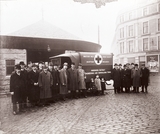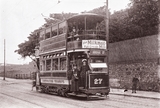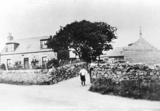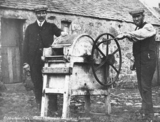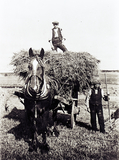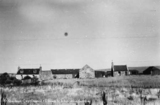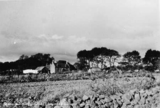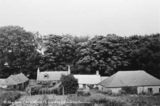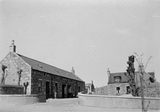|
Quick Search
|
Search Results
You searched for: More Like: 'Westerton and Caiesdykes Farm'
142 items
items as
Allenvale Cemetery from Kincorth
60 An early photograph of Allenvale Cemetery, taking shape in the middle distance, as seen from Kincorth, with Abbotswell Farm in the foreground.
A limited company called the Aberdeen Cemetery Company was established for the purpose of creating this new graveyard. A prospectus inviting public investment was published in the Aberdeen Journal of 29th January 1873. It reads as follows:
"It is well known that in Aberdeen cemetery accommodation is limited and insufficient, and it is generally admitted that its extension is necessary, and cannot much longer be delayed. It is therefore desirable to acquire additional space for that purpose, and to treat it in accordance with modern ideas and practice.
"This company has been formed for the purpose of providing an extensive Cemetery, in the neighbourhood of Aberdeen, suitable in all respects for the purposes of internment, and of easy access - but sufficiently removed from town to preserve its suburban character."
The new cemetery opened in late 1874 and, as we know, was a big hit. It was officially known as the Aberdeen Cemetery but quickly became known as Allenvale Cemetery, after the property on which it was built.
Allenvale saw major extensions in 1912 and 1932. A London syndicate purchased control of the graveyard from the Aberdeen Cemetery Company in 1958. Aberdeen Town Council subsequently took control of the cemetery in 1965 following the then owners going into liquidation and worries about Allenvale's future. Allenvale remains a fine example of a planned Victorian cemetery to this day.
Notable residents of Allenvale include John James Rickard MacLeod (1876-1935), co-discoverer of insulin, James Scott Skinner (1843-1927), fiddler and composer, and Mary Esslemont (1891-1984), the influential doctor. Though, of course, many interned at Allenvale would have their own interesting stories to tell.
In this photograph, Duthie Park, later created on the right, has yet to be landscaped. St. Machar Poorhouse, Fonthill House and Devanha House can all be seen in the distance. Old Aberdeen
71 A reproduced engraving showing the skyline of Old Aberdeen. The image looks north from around the lands of Sunnyside Farm.
In the foreground can be seen two agricultural labourers. On the skyline, going left to right, is the circular Powis Hermitage, on a hill, with its small spire, the twin spires of St. Machar Cathedral in the far distance, the tower of the Old Town House at the end of the High Street, which is protruding above the southern elevation of St. Mary's United Free Church.
Moving back along the High Street, the south facing front elevation, with bow windows, of Powis Lodge can be seen above the line of trees. The crown tower of King's College is across the street. The two minarets of the Powis Gateway are just next to it. Further along are the crenelations of Cromwell's Tower.
The tower on the far left of the image may be Dunbar's Tower.
The minaret gateway was finished in 1834 and this image likely dates from around that period. Red Cross Ambulance
364 A photograph from the presentation of a new ambulance by Aberdeen District engineering and shipbuilding firms to the Scottish Branch of the Red Cross Society on Monday 29th January 1917.
The vehicle, funded by subscription, was for use in Aberdeen and was handed over to Colonel J. Scott Riddell, the Red Cross Commissar. He can be seen fourth from the left in the group on the right.
The leftmost figure of that grouping is Lord Provost James Taggart. He presided over the presentation event that took place in the Red Cross Transport Headquarters on Holburn Street, visible here in the background. Taggart was a granite sculptor by trade and had a works nearby at 92 Great Western Road.
The location of this photograph is at the junction of Justice Mill and Holburn Street. A branch of the Summerhill Farm Dairy is visible in the background.
An account of the presentation and a list of subscribers can be read on page 3 of The Aberdeen Daily Journal for 22nd January 1917. No. 27 Tram
392 Many thanks to Silver City Vault users Dr Mike Mitchell and Brian Kennedy for providing us with information on this photo. It shows the no. 27 tram on Victoria Road with the wall of Balnagask House in the background.
The Balnagask Mains farm is partially visible to the left of the tram. The St. Fittick's Road terminus of the Torry Route is located further along Victoria Road.
The female conductor indicates the photo was taken during the Great War. The tram waits to depart for Bridge Street. Haymaking at Culter
1023 This photograph from the early 1900's shows a pair of farm workers loading a cart with hay. After the hay was cut it would be forked into haycocks in the fields, hopefully drying in the sun and wind. It would be turned regularly to ensure it became fairly dry or 'wun'. The man on top of the cart receives forkfuls of hay lifted up to him by the other men, and it was his job to arrange it so that it lay neatly and didn't unbalance and fall off as the cart travelled back to the farm. Once there loads of hay would be built into hayricks, thatched to ensure that rain didn't soak inside. Horsemen at a farm at Hirn, Banchory
1026 Since farmwork was entirely dependent on horses and horsemen a great deal of pride was taken in them. It was common in the early 1900's for itinerant photographers to travel around to take photos of the farm workers. Here we see three horsemen with their pairs of Clydesdales. Farmworkers had a strict division of labour so that cattlemen did not work with horses and vice versa. Horsemen had their own hierarchy - the most experienced man would be first horseman and the other took their place down to the youngest and least experienced. The first horseman would lead out to the fields and the others followed in order and they would work the fields in the same manner. Even when all the workers were hoeing fields horseman would outrank cattlemen. Lower Deeside Champion Ploughing Match
1047 This image shows the Committee of the Lower Deeside Champion Ploughing Match held at West Cults Farm on the 11th February 1922. In the centre of the front row, wearing a flat cap was the Secretary William E. Gibson. Behind him was Alexander Thomson, blacksmith in Cults, and to his right, was James Burnett on whose farm the match was held. The other gentlemen came from other farms in the surrounding area. The 'Aberdeen Daily Journal' reported that the weather was excellent and all arrangements were in perfect order. There were 64 competitors who had come from as far as Kinross in the south and Morayshire in the north, each with their pairs of well matched, faultlessly groomed and harnessed Clydesdales. The match was watched by around 2000 spectators. The winner was James Mowat, Newstyle, Foveran who received a silver cup and cash prize. Westerton of Auchmill Farm
1472 This photograph, likely by James G. Kellas and taken in around 1951, looks north west towards the farm of Westerton of Auchmill.
Its buildings are located just north east of the Northfield housing estate and remain at this location as of 2020. They are now largely bordered by Auchmill Golf Course, which also covers the previously nearby Dancing Cairns Quarry.
While the farm buildings still exist, this lane, which in the opposite direction would have lead to Westerton/Midtown Farm, has been replaced by the housing around Bonnyview Drive. Westerton Farm
1474 A photograph, likely by James G. Kellas and from around 1951, showing one of either two farms known as Westerton. Both have since been demolished.
It could be the Westerton Farm that was located on the old road that preceded Provost Fraser Drive. Near where Provost Fraser Drive now meets Springhill Road, in the space between Provost Fraser and Springhill Terrace.
This Westerton Farm was demolished shortly after this photograph was taken to make way for the development of the Northfield housing estate.
Across the old road from this farm was the lands of Springhill House and Farm.
The other Westerton Farm was just to the north east of Northfield Farm and a bit south of Dancing Cairns Quarry. This farm was also previously known as Midtown.
Like Northfield Farm (demolished late 50s/early 60s), this Westerton survived the initial development of Northfield as a housing estate. Ordnance Survey maps suggest the farm made way for the construction of Marchburn Court, and the extension of Smithyhaugh Road, in the mid-to-late 1960s.
It is difficult to say for certain which farm this photograph shows. The hills in the background perhaps suggest we are looking west towards the more northernly Westerton, the one nearer Northfield Farm. West Summerfield Farm
1475 This image has not yet been indexed. Use the Comments button below the image to enter information about the photograph.
Please note: we will not include any personal information provided unless you indicate that you wish to be acknowledged. The standard form for crediting your information is (name, place) e.g. (John Smith, Aberdeen). Springhill Farm
1476 A photograph of Springhill Farm. Looking north up Springhill Road. The building on the left can still been seen in 2017. The land around the farm and Springhill estate has been radically altered over the years. It is now flat parkland.
This photograph was likely taken by James G. Kellas in around 1951. Willowpark Croft farm
1479 This image has not yet been indexed. Use the Comments button below the image to enter information about the photograph.
Please note: we will not include any personal information provided unless you indicate that you wish to be acknowledged. The standard form for crediting your information is (name, place) e.g. (John Smith, Aberdeen). Raeden Farm
1480 This image has not yet been indexed. Use the Comments button below the image to enter information about the photograph.
Please note: we will not include any personal information provided unless you indicate that you wish to be acknowledged. The standard form for crediting your information is (name, place) e.g. (John Smith, Aberdeen). Old Town Farm
1481 This image has not yet been indexed. Use the Comments button below the image to enter information about the photograph.
Please note: we will not include any personal information provided unless you indicate that you wish to be acknowledged. The standard form for crediting your information is (name, place) e.g. (John Smith, Aberdeen). Silverhillock Farm
1482 An image looking north east showing Silverhillock Farm in the 1950s.
The property, through which flowed the Gilcomston Burn, was located at the junction of Westburn Road and Foresterhill Road.
The Royal Infirmary buildings can be seen in the background. Mains of Ruthrieston
1483 This photograph by James Kellas from the early 1950s shows a farm called Mains of Ruthrieston. It was located where Cranford Road joins Broomhill Road. This image looks north east from Cranford Road.
(Thanks to A. G. Duthie for identifying this location). Denhead Farm, Rubislaw
1484 This photograph by James Kellas from the early 1950s shows Denhead Farm in the area of Rubislaw. It was located on the south side of Carnegie Crescent, north of the western part of Rubislaw Den.
Local historian A. G. Duthie has been in touch to tell us that the Duncan family, who were tenants there, ran the farm as one of many market gardens in the Rubislaw Den area. It was a working farm until the later 1950s when it was demolished as part of residential development. Rosehill Farm
1485 A photograph, likely by James G. Kellas and from the early 1950s, showing Rosehill Hill Farm.
The large scale Ordnance Survey map surveyed in 1867, those revised in 1899 and in 1924 show the farm located on the north side of Cairncry Road. Rosehill Quarries were located to the north of the farm buildings.
The OS map surveyed in 1955 shows the farm surrounded by a modern housing estate. The buildings are then nos. 8, 10 and 12 Blackthorn Crescent.
The farm buildings later appear to have made way for new housing developments on Blackthorn Crescent and no remains of the farm can be seen today.
In the early 19th century the lands of Rosehill, along with Burnside and Ruthrieston, were acquired by Alexander Duthie, a successful advocate in Aberdeen, and later passed to his grandson Walter, a writer to the signet in Edinburgh. Walter was the uncle of Elizabeth Crombie Duthie, who donated Duthie Park to the people. See the latter's obituary in the Evening Express of 30th March 1885, page 3, for further detail. |






